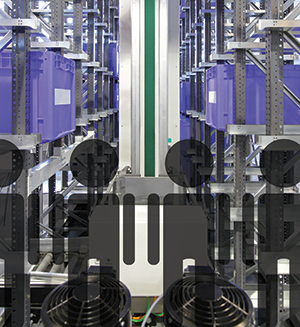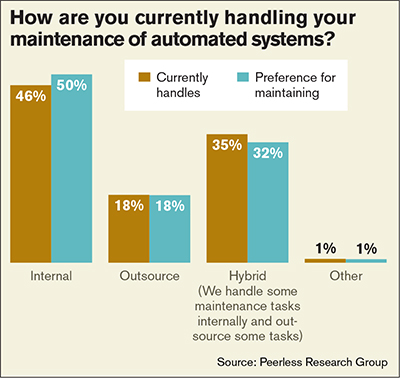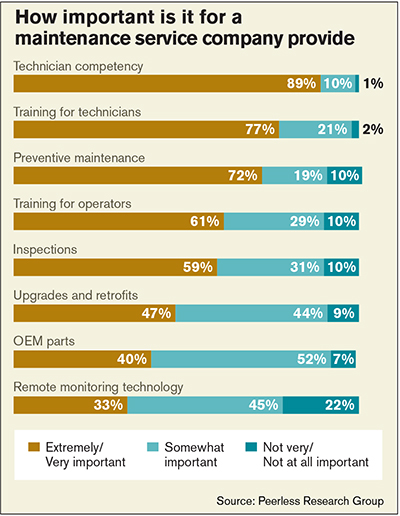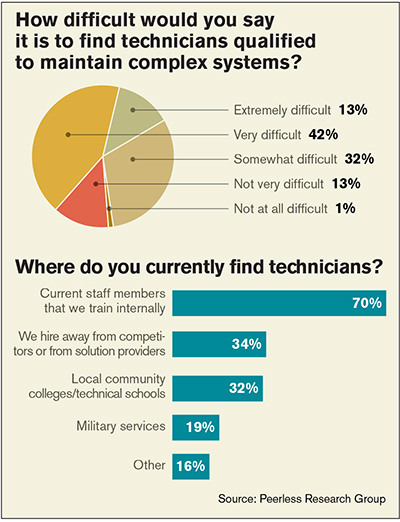Reader survey: Maintaining the automated warehouse
Modern Material Handling’s first-annual Maintenance Study reveals fairly high adoption rates for automated warehouse systems and an ongoing need for quality maintenance support and skilled technicians to manage these setups.

Anyone working in a contemporary warehouse or distribution center understands that technology is advancing at the speed of light. That is especially true as manufacturers and distributors gear up to handle the challenges of complex order fulfillment strategies, earlier and earlier order cutoff times, more value-added services, faster delivery expectations and more returns than ever.
With all that extra handling, it’s no surprise that warehouses and DCs alike are equipped with more automated materials handling systems, data collection technologies and software than ever before. That’s the good news. The bad news is that all of that automation and technology is not only more complicated to maintain than ever before, it is being implemented at a time when a generation of skilled technicians is about to retire and new technicians are hard to find.
What then is the state of maintenance and technicians amongst our readers? For Modern Material Handling’s first-annual Maintenance Study, conducted by Peerless Research Group (PRG) last month, we communicated with 100 leading warehouse and DC professionals representing a variety of industries. Here’s a look at the results of the study as well as what our readers have told us about the current levels of automation in their facilities, how they handle the ongoing maintenance of their automated equipment, and the key challenges they face in hiring technicians and/or outsourcing maintenance to third parties.

Taking the automated route
Automated warehouse and DCs comprise a variety of hardware and software components including fixed machinery like automated cranes and conveyors, sortation systems, industrial robots, automated storage and retrieval systems (AS/RS); mobile data collection technology and devices; and integration and operational control software. Equipped to handle the rigors of today’s multi-faceted facilities, these systems help increase efficiencies while reducing the costs of running a largely manual warehouse.
Respondents appear to be embracing the need for more automation within their warehouses and DCs. According to the survey, a significant percentage of companies are currently using at least some level of automation within their facilities. The survey found that 13.4% of respondents’ warehouses/DCs are 75% to 100% automated. Nearly 54% of respondents are either 50% to 75% automated or 25% to 50% automated, while 29.9% say they still handle processes manually. If the industry continues to experience double-digit growth, expect to see that last number drop over the next few years as more warehouse owners warm up to the idea of automation within their four walls.
And while automated warehouse systems provide clear benefits to those companies that use them, they also present some unique challenges.
Ongoing maintenance, for example, is a requirement that must be supported by a knowledgeable in-house or outsourced team of skilled technicians. That’s because the systems themselves are becoming harder to maintain and finding the technical ability to maintain them is a challenge, according to 40.5% of the survey respondents. About 58% say they have a difficult time finding the technical skills needed to maintain their systems. Roughly 20% of companies would like to have a technician from a third-party provider reside at their facilities and manage the maintenance for them.
One way Modern’s readers are managing ongoing maintenance of their automated equipment is through service agreements with their solution providers. According to the survey, 56.3% of companies currently have maintenance service contracts with their vendors and 43.8% do not. Those that do have such contracts in place should be well positioned to have their equipment and software maintained over time without the need for robust, in-house technical expertise.

Expertise wanted
As omni-channel fulfillment continues to evolve, companies are investing in more technology to help support their e-commerce and related distribution channels. In fact, 35.8% of survey respondents say that their MRO requirements are being driven by their business’ e-commerce efforts.
To most effectively manage the maintenance of the automated systems that support those e-commerce efforts, 46.3% rely on internal staff members while 34.7% use a “hybrid” approach that involves handling some maintenance tasks internally and outsourcing others. Additionally, 17.9% of respondents outsource maintenance completely. Tasks performed by those outsourcing firms include maintenance of automated systems (conveyors, lifts, etc.) (56.3%), lift truck fleet maintenance (39.6%), off-site systems monitoring (16.7%), and maintenance tasks for the entire facility (12.5%).
Regardless of who they’re using to maintain the automated systems in their warehouses/DCs, respondents would prefer those systems are maintained internally (49.5%), on a hybrid basis (31.6%), or outsourced to a third party (17.9%). When evaluating maintenance and service providers, the key criteria used includes timely service (82.3%), technician skill level (76%), expertise across all makes/models of equipment (45.8%), and company reputation (44.8%). Other considerations include the use of quality products, the breadth of maintenance program/service offerings and the size of the service group.
According to the survey respondents, it’s very important for maintenance service companies to provide competent technicians, preventive maintenance, inspections, technician training and training for operators. Ranking slightly lower on the must-have list were competencies like upgrades and retrofits, remote monitoring technology, and OEM parts. In reviewing various open positions currently posted online for automated warehouse technicians, companies also expect skills like advanced knowledge of electrical, electronic and mechanical technology; experience in using test equipment (such as graphic sequencers, oscilloscopes, voltmeters and logic testers); experience in troubleshooting electrical, electronic, pneumatic and mechanical malfunctions; and a knowledge of mini-computers.
Of course, once in place these technicians also need to have access to parts and support to manage their own repair and maintenance efforts. When obtaining and accessing spare parts, survey respondents typically turn to their distributors (67.4%), systems suppliers (56.8%), OEMs (56.8%), or other providers (11.6%).

Training technicians
When it comes to finding technicians who are qualified to maintain complex systems, 54.2% of companies participating in the survey say the undertaking is either “extremely difficult” or “very difficult.” Another 31.9% say the task is “somewhat difficult,” while 13.9% are not challenged in this area.
Consider, for example, the California winery that posted a job for an “automated warehouse technician” on LinkedIn this past January. Lengthy and detailed, the firm’s list of “must haves” included a BS degree in electrical engineering or computer engineering to “monitor and improve the production processes, quality and product flow in our warehouse, with the goal to make the overall production efficiency as high as possible.” Top job responsibilities included assisting with documentation of all existing as well as new installations concerning electrical, product lifecycle and plant improvements; maintaining all mechanical repairs and upkeep of the cart elevator system; improving older controls equipment and providing “hands-on” commissioning of all new machinery (the list didn’t end there, but those were the major points).
As evidenced by this single job post, the tasks being put in front of today’s automated warehouse technicians are varied and complicated. According to our survey, most companies (69.5%) are filling these positions by training their internal, existing staff members. Another 33.7% are hiring workers away from competitors or solutions providers, while 31.6% rely on local community colleges and technical schools to round out their technician ranks. Another 19% of companies hire through the various branches of the military and 15.8% use “other” sources.
Given these challenges, you would think that warehouse and DC operators would put a premium on training. However, internal training is a mixed bag when it comes to keeping technicians up to date on the latest and greatest developments in automated warehouse technology. When asked whether they have formal training programs in place for the technicians who work on their automated warehouse systems, 54.3% of respondents say they do while 45.7% do not. We can surmise that the latter group probably comprises most of the respondents who say they either outsource maintenance to a third party and/or rely on their solutions providers’ ongoing maintenance agreements.


Article Topics
Latest in Materials Handling
ASME Foundation wins grant for technical workforce development The (Not So) Secret Weapons: How Key Cabinets and Asset Management Lockers Are Changing Supply Chain Operations MODEX C-Suite Interview with Harold Vanasse: The perfect blend of automation and sustainability Consultant and industry leader John M. Hill passes on at age 86 Registration open for Pack Expo International 2024 Walmart chooses Swisslog AS/RS and software for third milk processing facility NetLogistik partners with Vuzix subsidiary Moviynt to offer mobility solutions for warehouses More Materials HandlingAbout the Author
Subscribe to Materials Handling Magazine

Find out what the world's most innovative companies are doing to improve productivity in their plants and distribution centers.
Start your FREE subscription today.
April 2024 Modern Materials Handling

Latest Resources










